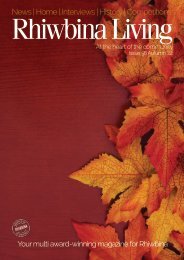Rhiwbina Living
Summer 2023 issue of Rhiwbina Living, the award-winning magazine for Rhiwbina.
Summer 2023 issue of Rhiwbina Living, the award-winning magazine for Rhiwbina.
- TAGS
- wales
- whitchurch
- rhiwbina
- cardiff
You also want an ePaper? Increase the reach of your titles
YUMPU automatically turns print PDFs into web optimized ePapers that Google loves.
outdoors<br />
Common goby<br />
The common goby can be found along most of the UK's<br />
coastline; in fact, it can be found anywhere from the Baltic<br />
Sea to the western Mediterranean.<br />
You'll find these little fish in estuaries, saltmarshes, along<br />
the coastline and in intertidal pools. They do prefer open<br />
water areas that are muddy or sandy, but can often be<br />
found in dense vegetation. Because of their colour, they<br />
can often blend in with the mud or sand beneath them.<br />
They grow to about 6cm long and you can distinguish<br />
them from other species by the fact that its nape and<br />
throat are completely scaleless. They have large eyes that<br />
are positioned on the sides of their heads.<br />
Common starfish<br />
The common starfish has five arms<br />
and usually grows to between 10–<br />
30cm across.<br />
It is dioecious, meaning that each<br />
individual is either male or female. In<br />
the spring, the females release their<br />
eggs into the sea. A moderate sized<br />
starfish is estimated to be able to<br />
produce 2.5 million eggs.<br />
They eat by opening up shellfish,<br />
inserting a part of their stomach into<br />
the shellfish, digesting its contents,<br />
and then returning its stomach back to<br />
its body. They can live for up to seven<br />
or eight years.<br />
Common limpet<br />
These small cone-like structures<br />
clamp onto the rocks and wait for<br />
the tide to return.<br />
When it does, they release<br />
themselves and get on the move,<br />
eating algae with their tongue - the<br />
world’s strongest known biological<br />
structure - as it needs to constantly<br />
scrape algae from the tough rocks.<br />
Its tongue contains hundred of rows<br />
of sharp teeth that are known to be<br />
stronger than steel.<br />
Brown shrimp<br />
Also known as the common<br />
shrimp, this crustacean can be<br />
found on all coastlines in the UK.<br />
often lurking in estuaries and<br />
shallow waters.<br />
Adults typically measure 1-2<br />
inches long, with large antennae<br />
They can also change colour to<br />
better match their surroundings<br />
using special cells called<br />
chromatophores. Usually brown<br />
to blend in with the sand, if they<br />
are threatened by predators,<br />
they bury themselves in the<br />
sand. During the day, they remain<br />
buried in the sand to escape<br />
predatory birds and fish, with only<br />
their antennae protruding.<br />
13

















